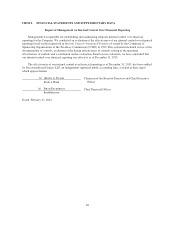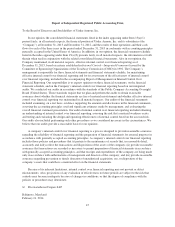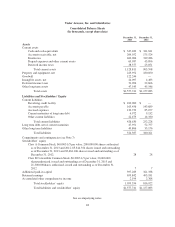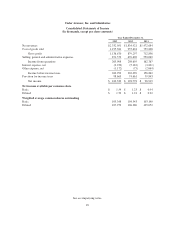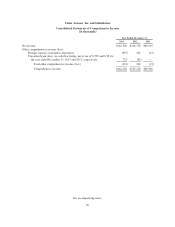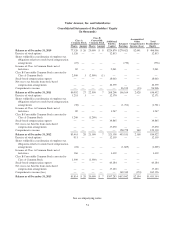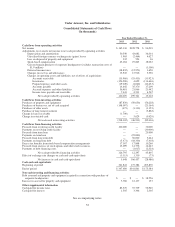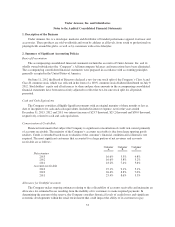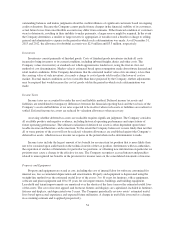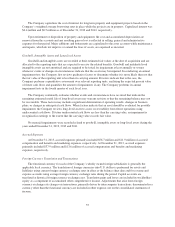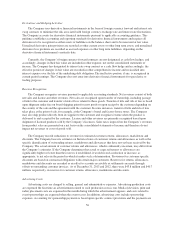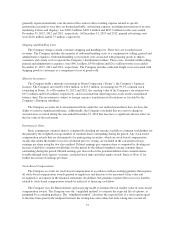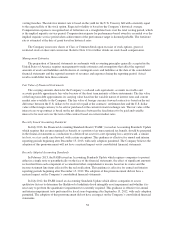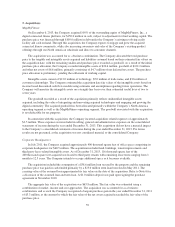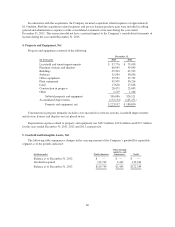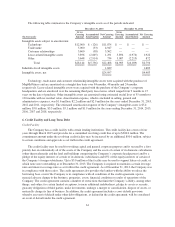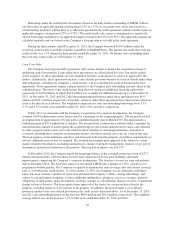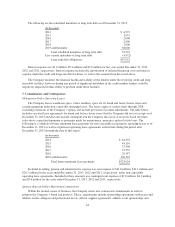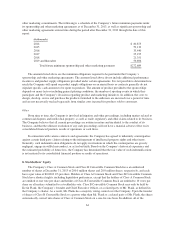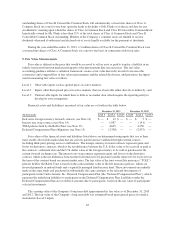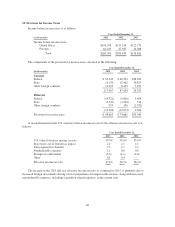Under Armour 2013 Annual Report Download - page 66
Download and view the complete annual report
Please find page 66 of the 2013 Under Armour annual report below. You can navigate through the pages in the report by either clicking on the pages listed below, or by using the keyword search tool below to find specific information within the annual report.Derivatives and Hedging Activities
The Company uses derivative financial instruments in the form of foreign currency forward and interest rate
swap contracts to minimize the risk associated with foreign currency exchange rate and interest rate fluctuations.
The Company accounts for derivative financial instruments pursuant to applicable accounting guidance. This
guidance establishes accounting and reporting standards for derivative financial instruments and requires all
derivatives to be recognized as either assets or liabilities on the balance sheet and to be measured at fair value.
Unrealized derivative gain positions are recorded as other current assets or other long term assets, and unrealized
derivative loss positions are recorded as accrued expenses or other long term liabilities, depending on the
derivative financial instrument’s maturity date.
Currently, the Company’s foreign currency forward contracts are not designated as cash flow hedges, and
accordingly, changes in their fair value are included in other expense, net on the consolidated statements of
income. The Company has designated its interest rate swap contract as a cash flow hedge and accordingly, the
effective portion of changes in fair value are recorded in other comprehensive income and reclassified into
interest expense over the life of the underlying debt obligation. The ineffective portion, if any, is recognized in
current period earnings. The Company does not enter into derivative financial instruments for speculative or
trading purposes.
Revenue Recognition
The Company recognizes revenue pursuant to applicable accounting standards. Net revenues consist of both
net sales and license and other revenues. Net sales are recognized upon transfer of ownership, including passage
of title to the customer and transfer of risk of loss related to those goods. Transfer of title and risk of loss is based
upon shipment under free on board shipping point for most goods or upon receipt by the customer depending on
the country of the sale and the agreement with the customer. In some instances, transfer of title and risk of loss
takes place at the point of sale, for example, at the Company’s brand and factory house stores. The Company
may also ship product directly from its supplier to the customer and recognize revenue when the product is
delivered to and accepted by the customer. License and other revenues are primarily recognized based upon
shipment of licensed products sold by the Company’s licensees. Sales taxes imposed on the Company’s revenues
from product sales are presented on a net basis on the consolidated statements of income and therefore do not
impact net revenues or costs of goods sold.
The Company records reductions to revenue for estimated customer returns, allowances, markdowns and
discounts. The Company bases its estimates on historical rates of customer returns and allowances as well as the
specific identification of outstanding returns, markdowns and allowances that have not yet been received by the
Company. The actual amount of customer returns and allowances, which is inherently uncertain, may differ from
the Company’s estimates. If the Company determines that actual or expected returns or allowances are
significantly higher or lower than the reserves it established, it would record a reduction or increase, as
appropriate, to net sales in the period in which it makes such a determination. Provisions for customer specific
discounts are based on contractual obligations with certain major customers. Reserves for returns, allowances,
markdowns and discounts are recorded as an offset to accounts receivable as settlements are made through
offsets to outstanding customer invoices. As of December 31, 2013 and 2012, there were $43.8 million and $40.7
million, respectively, in reserves for customer returns, allowances, markdowns and discounts.
Advertising Costs
Advertising costs are charged to selling, general and administrative expenses. Advertising production costs
are expensed the first time an advertisement related to such production costs is run. Media (television, print and
radio) placement costs are expensed in the month during which the advertisement appears, and costs related to
event sponsorships are expensed when the event occurs. In addition, advertising costs include sponsorship
expenses. Accounting for sponsorship payments is based upon specific contract provisions and the payments are
56


